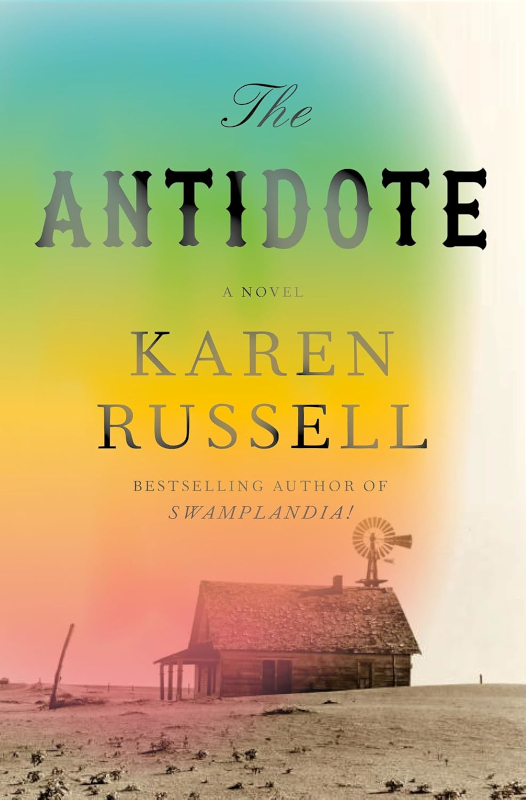Goodreads blurb: The Antidote opens on Black Sunday, as a historic dust storm ravages the fictional town of Uz, Nebraska. But Uz is already collapsing—not just under the weight of the Great Depression and the Dust Bowl drought, but beneath its own violent histories. The Antidote follows a “Prairie Witch,” whose body serves as a bank vault for peoples’ memories and secrets; a Polish wheat farmer who learns how quickly a hoarded blessing can become a curse; his orphan niece, a basketball star and witch’s apprentice in furious flight from her grief; a voluble scarecrow; and a New Deal photographer whose time-traveling camera threatens to reveal both the town’s secrets and its fate.
Russell’s novel is above all a reckoning with a nation’s forgetting—enacting the settler amnesia and willful omissions passed down from generation to generation, and unearthing not only horrors but shimmering possibilities. The Antidote echoes with urgent warnings for our own climate emergency, challenging readers with a vision of what might have been—and what still could be.
My review: I don’t know where to start. This book is a lot. This was my first time reading Karen Russell’s work, and I can fully understand why she was a Pulitzer finalist. Her prose is magnetic – at times it draws you in, at other times it repels you, but it’s always a force to be reckoned with. I like to use food metaphors for reading, because to me the written word is food for the brain, so I would classify Russell’s work as a really heavy meal with almost too many courses. It’s delicious and very nourishing, but… it’s a lot. There were times when my brain got tired of chewing (so to speak).
If the blurb above gives you Wizard of Oz vibes (a town called Uz, a storm, a witch, a scarecrow, an orphaned teenage girl), that seems to be intentional. An object that comes up a lot in the plot is even described as “emerald” in colour. I couldn’t for the life of me figure out why Russell kept planting all these Wizard of Oz Easter eggs, though, since the story had nothing in common with it. I was hyper-aware of any possible parallels, and I found it distracting to be constantly looking for something that wasn’t there.
As for what was there… this novel tries to be everything all at once. It’s a murder mystery, with what seems to be a serial killer on the prowl. It’s magical realism, with a sentient scarecrow, a witch who can absorb people’s memories, and a camera that can see the past and the future, all accepted as things that can happen in this otherwise-realistic setting. It’s climate fiction, with the Dust Bowl drought offering many opportunities for reprimands against destructive colonial practices that upset the balance of nature and lead to disastrous consequences. It’s an allegory for the stock market crash, with the memory-absorbing witch losing her “deposits” just as people are demanding them back. It’s a queer coming-of-age story about a teenage girl who discovers she’s in love with her best friend. It’s an examination of the mother/child bond, and what can happen to a person when that bond is severed. It looks at the poor treatment of unwed mothers in the time period; the irony of immigrants arriving in America to escape persecution and turning into persecutors themselves; the nature of memory and what we become when we can’t remember the moments that made us who we are; and, perhaps most earnestly, what needs to be done towards reconciliation with the Indigenous peoples of North America. All of these aspects of the novel are written beautifully, and they mostly do come together at the end, but the weight of each thread required more of the ending than I think it was possible to deliver. I was left disappointed on a few counts, since Russell gave more focus to wrapping up parts of the story that I cared the least about. Your mileage may vary.
Overall, I think the main message of the novel is that we Westerners tend to engage in purposeful forgetfulness when we learn the hard truths of colonization. We think to ourselves, “What’s done is done,” but what’s done is still being done and will continue to be done until everyone starts taking reconciliation seriously. Russell has some important and timely things to say about that, and she says it brilliantly. I just wish she’d pared down the number of important conversations she was trying to have in this one novel. The room started to get a little loud.
I do recommend this book, though. A lot of people are giving it a solid 5 stars, while others are DNF’ing partway through. My feelings about it are somewhere in the middle. It’s always best to make up one’s own mind about a work like this, especially when it’s entirely possible that it might become assigned reading in future English courses. I think it would be a good one for class discussions, so it wouldn’t surprise me if someday soon you find it listed on a syllabus near you.
(Note: If you’re in the US and are interested in purchasing a copy of this book, please consider using this affiliate link to Bookshop.org, where any purchase you make will earn a small commission both for me and for a local independent bookstore of your choice, without any additional cost to you. Thanks for your support!)
